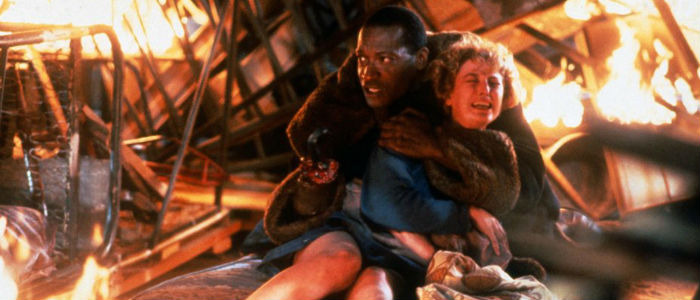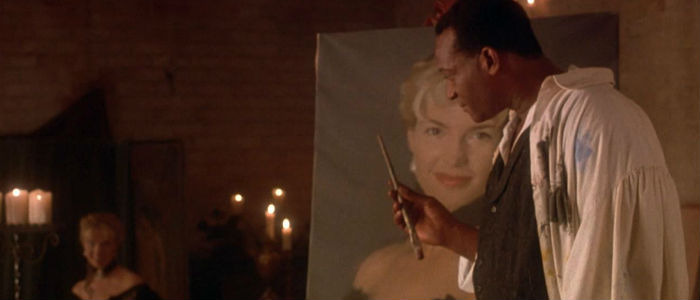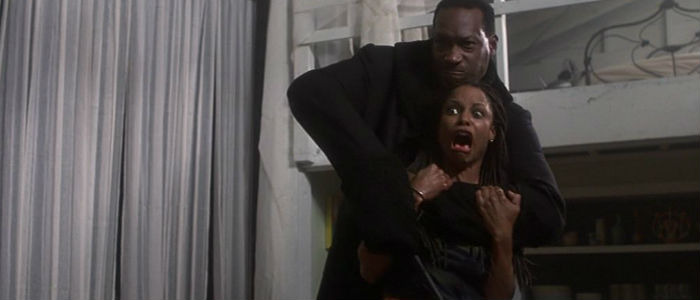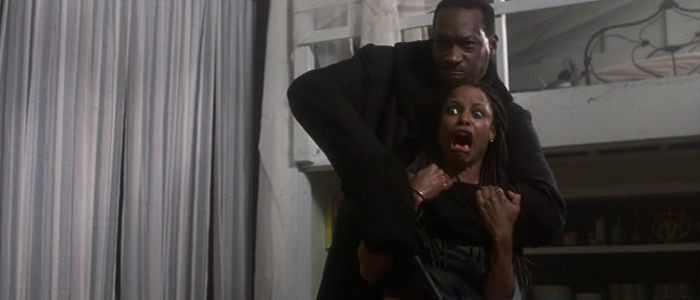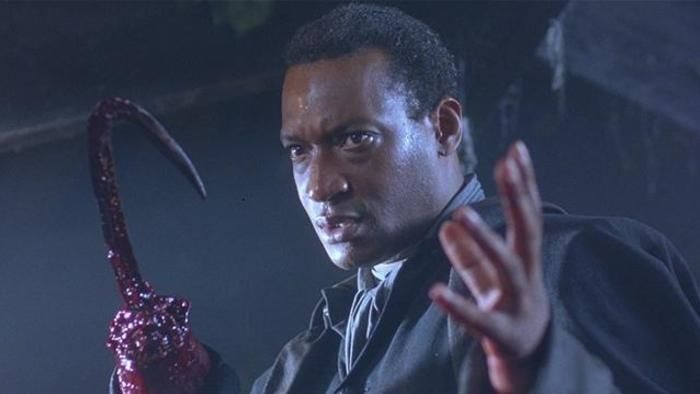'Candyman: Day Of The Dead' Fails To Understand Candyman
(Welcome to DTV Descent, a series that explores the weird and wild world of direct-to-video sequels to theatrically released movies. In this edition, we see what all the buzz is about with this Candyman guy who just might be on the cusp of a high-profile remake.)
One of the big movie news items this week – more of a rumor actually – was the report that Oscar winner Jordan Peele may be remaking Candyman. It's unclear if he's just producing or if he'll write and/or direct the film too, and it's equally unknown if it will be a straight remake or if they'll go back to the source of Clive Barker's short story "The Forbidden." Hell, it might not even be true at all. The only thing we know for sure is that Candyman is a fantastic horror film blending new mythology, bloodletting, and some fascinating observations on race and social issues.
Not nearly enough people have seen it (or heard Philip Glass' brilliantly memorable score), and even fewer have watched the less-inspired sequel that followed in theaters three years later. And four years after that? No one even noticed another sequel go straight to DVD.
But that's why I'm here – to remind you that these things exist. So keep reading for a look at 1999's Candyman: Day of the Dead, and together we'll discover if it's worth seeking out before Peele's remake maybe, possibly comes along.
The Beginning
Candyman (1992) follows a young woman whose research into folklore and urban legends leads her to Chicago's ruinous Cabrini Green housing complex. The apartment buildings are overrun by drug dealers and petty crime, but a recent series of murders holds the tenants in the grip of fear for reasons beyond the obvious. They believe the hook-handed Candyman – a former slave turned artist named Daniel who was mutilated and murdered by a mob for falling in love with a white woman – has been carving up victims in the complex, and she sees their acceptance of this reality as something worthy of further research. She discovers too late that the legend is true, and soon Candyman is toying with her as he slices his way through those around her and reveals that she's the reincarnation of his long-dead lover.Candyman: Farewell to the Flesh (1995) moves the action from Chicago to New Orleans as an author touring with his book about the legendary Candyman killings is himself gutted by the angry entity. The vengeful spirit's story is fleshed out a bit more as we learn his torture involved being forced to look at his newly disfigured presence in a mirror – a mirror that now holds his soul. This is why fools are able to summon him by saying his name five times into a mirror! The original mirror is the key, though, and after learning that she's a descendant of Daniel and his white lover, a young teacher who's already lost a father, husband, and brother to the spirit's blade sets out to end his legend forever by finding and destroying it.
The DTV Plot
Caroline's mother – the teacher from Farewell to the Flesh – took her own life a few years ago, leaving her grown daughter to face the world's questions about Daniel Robitaille, AKA Candyman. (So yes, while it's been four years in the real world, roughly 25 years have passed in the world of the movie.) She doesn't believe in the legends, of course, and would rather focus on her great-great-great grandfather's more artistic endeavors, but that all changes after being goaded into saying his name five times in front of a mirror. The hook-happy killer is back, and he won't rest until his blond descendant agrees to be his victim. If she refuses, Candyman will continue sneaking up behind the people in her life and gutting them with his razor-sharp, highly impractical hook while she stares in disbelief instead of warning them to move.
Talent Shift
The Candyman franchise originated with Clive Barker's short story, but writer/director Bernard Rose (Immortal Beloved, 1994) brought him to the screen for the first time. He beautifully adapted Barker's exploration of folklore into a tale that feels uniquely American, and the themes come to a powerful conclusion as Helen becomes a whispered legend herself. Virginia Madsen gives a strongly compassionate performance despite wrapping the film in one of cinema's worst bald caps, Tony Todd created an instantly iconic genre character, cinematographer Anthony B. Richmond (Don't Look Now, 1973) captures real beauty in the urban landscape, and Philip Glass' score is just a stunner for your ears.
Bill Condon (Gods and Monsters, 1998) had the unenviable position of following up Rose's modern classic, but while he finds some engaging visuals, the script (by Rand Ravich and Mark Kruger) isn't doing anyone any favors. It gives Candyman a bit too much dialogue, and it rehashes the original's social themes while weaving in the family dynamic that motivates the title specter. Condon's grip on the film is strong enough to make for a passable horror experience, but it's endlessly reliant on sound stingers for scares, which are more annoying than effective. Kelly Rowan, meanwhile, can't quite measure up to Madsen's turn, but still gives a respectable performance.
Which brings us to Day of the Dead and director/co-writer Turi Meyer (Sleepstalker, 1995), who followed this mess with a successful career in television (Smallville). He and co-writer Al Septien were apparently comfortable in the DTV sequel game, as they also gifted the world with Leprechaun 2 (1994) and Wrong Turn 2: Dead End (2007), but even a cursory glance at their filmography reveals that the scariest film they wrote was 1998's Chairman of the Board starring Carrot Top. And the on-screen lead here carrying the film's emotional weight opposite the returning Tony Todd? The host of Battle Bots herself, Donna D'Errico.
How the (Second) Sequel Respects the Original
Day of the Dead tries to continue the themes of social discord from the preceding two films and also retains the familial thread, but its biggest sign of respect is the continued employment of Todd in the title role.
How the (Second) Sequel S***s on the Original
While the original is an exploration of folklore and urban legends and the second continues those themes, the third gets lost in its attempt to translate these ideas elsewhere. Sure, our protagonist is yet another blond girl entering a minority community – if Peele does reboot Candyman, I'm hoping this is the first element he changes – but rather than focus on the black community, the film shifts poorly to Hispanic culture. It feels every bit like a lazy attempt to make the story feel different (it doesn't) while still maintaining an engaging commentary (it doesn't). Not only does the Hispanic element lack a direct connection to Robitaille's post-slavery life and death, it's also forced in with the subtlety of a hook to the throat.
Caroline crosses paths with "gangbangers" who turn out to be perfectly nice people whose struggles come in the form of police harassment, and the issue is raised multiple times to stress the troubles they face as minorities. There's an obvious truth to it, but there's no narrative connection. The first film's approach to inner-city Black culture framed poverty as a continuation of the bondage and lack of opportunity afforded Black people even after the end of legal slavery. The thematic move towards creating mythologies to explain the troubles and tribulations they face is absent here – Candyman is still Candyman with the same history – and the closest the film gets to Hispanic culture is to have one character's abuela shake her beads in Caroline's general direction and curse an otherwise perfectly good egg.
The other big misstep here is the film's use of a particularly uninspired slasher trope. While Candyman has slasher elements, it never played into them with its female characters. Here, though, we not only get Caroline naked and traumatized in the shower, but we also get two other women murdered while topless. There's nothing wrong with nudity, of course, but three women victimized while nude is three too many for this kind of horror film. It feels cheap and unnecessary and it's just one of many elements that make it clear these filmmakers don't understand Candyman.
Rather than appear in order to instill fear or give a name to people's tribulations, Candyman is hanging around so he can bone his busty descendant in the afterlife? It's gibberish, and while the film tries to lay the character's pathos on thick, he loses his tragic nature by being reduced to a mere horndog. The film also relies way too heavily on dream sequences, flashbacks, and a highly annoying visual/aural stutter every time it reveals "shocking" imagery.
Conclusion
This is a rare entry in this column in which the DTV sequel follows a theatrical sequel, and to that end the drop in quality here is softened a bit. A direct comparison between the original Candyman and Day of the Dead would be laughable, but with the buffer of the passable Farewell to the Flesh in between, this is just another bad movie that deservedly went straight to DVD. If you've managed to miss it this long, I suggest you continue to do so.

